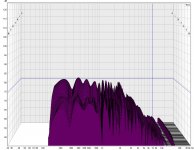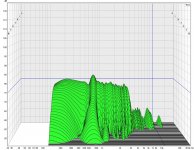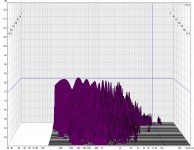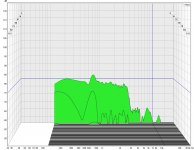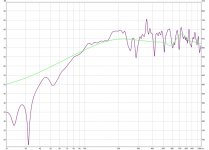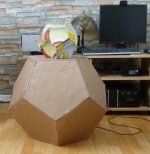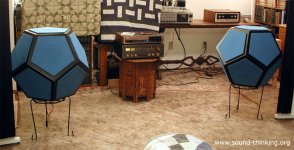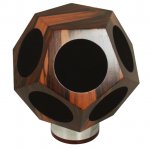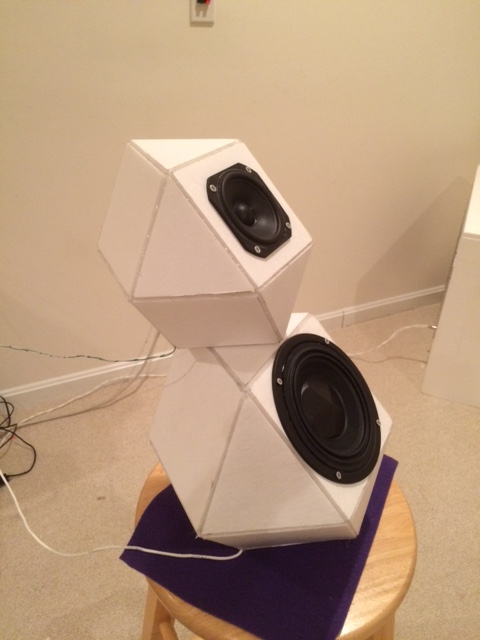Hi BYRTT,
I agree with you. I don't think enclosure resonance is necessarily a good thing. Since the enclosure *must* resonate, I believe that low amplitude wide-band resonance would be a good thing. I have not been able to directly show thus far that the enclosure resonance is actually improving the sound (or adding a sense of ambiance), but I have shown that the sound is cleaner than with a sealed box. Everyone knows about the tradeoffs that must be made when choosing between sealed or ported/TL etc....Compared to a sealed box, I find that the hypercube enclosure has more bass output and less harmonic distortion and ringing. As far as I know, the other popular designs improve output and reduce harmonic distortion by introducing time-domain distortion (group delay and/or ringing). This is not a tradeoff I have been happy making. I know the dodecahedron makes for stiffer panels than a simple box which is why I made my sealed box double the thickness of the hypercube. The hypercube still sounds/measures much better.
I agree with you. I don't think enclosure resonance is necessarily a good thing. Since the enclosure *must* resonate, I believe that low amplitude wide-band resonance would be a good thing. I have not been able to directly show thus far that the enclosure resonance is actually improving the sound (or adding a sense of ambiance), but I have shown that the sound is cleaner than with a sealed box. Everyone knows about the tradeoffs that must be made when choosing between sealed or ported/TL etc....Compared to a sealed box, I find that the hypercube enclosure has more bass output and less harmonic distortion and ringing. As far as I know, the other popular designs improve output and reduce harmonic distortion by introducing time-domain distortion (group delay and/or ringing). This is not a tradeoff I have been happy making. I know the dodecahedron makes for stiffer panels than a simple box which is why I made my sealed box double the thickness of the hypercube. The hypercube still sounds/measures much better.
I ran a measurement from the rear of the sealed enclosure to compare to the (stuffed) hypercube. The SPL from the rear of each enclosure appears to be the same for the majority of the spectrum however the response of the hypercube is much smoother (sealed measurement needs to be smoothed to 1/6 octave to resemble the hypercube without smoothing) and there is more output in the bass.
My original claim of increased "efficiency" was based on a measurement I made showing increased SPL of the low frequencies and the also the sound I was hearing from the rear of the enclosure which was much better than with the sealed box. This claim appears to not be valid (above ~120hz), at least with my enclosure. I apologize if this was misleading to anyone; that was certainly not my aim. I do still think this is a great enclosure however.
I viewed and captured the measurements as waterfall plots and I think the results are pretty interesting. The rear response of each enclosure is shown over an 8ms and 110ms period. It seems that with the hypercube, in addition to the previously mentioned differences, there is a lot less ringing.
Perhaps the decreased enclosure ringing is what gives the impression of a more omnidirectional sound and makes the speaker sound better when heard from the rear.
My original claim of increased "efficiency" was based on a measurement I made showing increased SPL of the low frequencies and the also the sound I was hearing from the rear of the enclosure which was much better than with the sealed box. This claim appears to not be valid (above ~120hz), at least with my enclosure. I apologize if this was misleading to anyone; that was certainly not my aim. I do still think this is a great enclosure however.
I viewed and captured the measurements as waterfall plots and I think the results are pretty interesting. The rear response of each enclosure is shown over an 8ms and 110ms period. It seems that with the hypercube, in addition to the previously mentioned differences, there is a lot less ringing.
Perhaps the decreased enclosure ringing is what gives the impression of a more omnidirectional sound and makes the speaker sound better when heard from the rear.
Attachments
VERY interesting, gmad. I think that you and xrk971 have demonstrated fairly well that there is less ringing in the rhombic dodecahedron enclosure. The waterfall plots are clear to me in that regard. Others would be happier with double-blind tests, but you would think that automated testing makes it harder to jigger the data. In my experience people do tend to like the sound of this design, which unfortunately leaves them open to criticisms of experimenter bias if they do testing of any kind.
I can say that I have never done a conversion of existing loudspeakers to our enclosures where the customer comparison-listened and said, "no, put them back they way they were." But besides being completely anecdotal, such a statement would not be considered evidence of improvement because of the inherent subjectivity of the listening experience.
I agree that omnidirectionality is more difficult to show unambiguously. I can understand some not wanting to consider it without a turntable in an anechoic chamber or a large array of microphones, both of which tend to be beyond the means of diy researchers.
One question that remains to be resolved is how to measure and sum up the acoustic energy radiated in 4 pi steradians (how would you measure the component going straight down into the floor or rug in addition to the on-axis reading?). If there were a convenient way of doing that we would be able to tell whether the design is actually harnessing the backwave for extra ambiance...or merely shunting or redistributing some of the frontwave energy to panel vibration. One would expect you would get more "ambience" if you had little rubber feet on the bottom panel resting in a hard floor...rather than the bottom rhombus lying flat on the floor and thus more inhibited in its movement.
I have made prototypes both with and without feet. In practice, I have found cabinet feet usually unnecessary myself. But different ears might disagree.
I can say that I have never done a conversion of existing loudspeakers to our enclosures where the customer comparison-listened and said, "no, put them back they way they were." But besides being completely anecdotal, such a statement would not be considered evidence of improvement because of the inherent subjectivity of the listening experience.
I agree that omnidirectionality is more difficult to show unambiguously. I can understand some not wanting to consider it without a turntable in an anechoic chamber or a large array of microphones, both of which tend to be beyond the means of diy researchers.
One question that remains to be resolved is how to measure and sum up the acoustic energy radiated in 4 pi steradians (how would you measure the component going straight down into the floor or rug in addition to the on-axis reading?). If there were a convenient way of doing that we would be able to tell whether the design is actually harnessing the backwave for extra ambiance...or merely shunting or redistributing some of the frontwave energy to panel vibration. One would expect you would get more "ambience" if you had little rubber feet on the bottom panel resting in a hard floor...rather than the bottom rhombus lying flat on the floor and thus more inhibited in its movement.
I have made prototypes both with and without feet. In practice, I have found cabinet feet usually unnecessary myself. But different ears might disagree.
Tesserax,
Have you ever tried a multi-way speaker by stacking rhombic dodecahedrons?
On my to do list 🙂
Good question, Muddjester. Originally we used to put multi-driver systems all on the same rhombic dodecahedron. Later we wondered if separate enclosures for, say, the woofer and midrange cones in a 3-way system might not be a good idea. We figured it might be a better idea for the woofer to not be driving the midrange -- that separate enclosures might be the best way for each driver to do its own thing without interference.
But to be fair, although we tried it, we have no test data to show that it is superior to the all-on-one system, though it is reasonable to assume the acoustics would be a little better with separate enclosures.
Personally, I prefer systems with full-range drivers or quality coaxials, so that all the frequencies appear to emanate from one point in space, for better soundstaging/imaging. But it is very possible that multi-enclosure systems would be preferred by people who don't like the idea of the woofer pushing the midrange cone back and forth and thus theoretically modulating the midrange output with low-frequency carriers.
Since we have no test data about the magnitude of the improvement it might obtain, however, it is an excellent suggestion for further research.
Here's a couple if pics of a 3-way system we built once. In the second image you can see that the midrange cone on the right has its own separate rhombic dodecahedron sub-enclosure, inside the larger one and only visible when the woofer is off the baffle plate. You can also see how thin the wood (gum plywood in this case) is. We made this set hoping to get it tested by Hirsch-Houk Labs, but it didn't happen. You can also see we learned of the necessity of shock-absorbing boxes. This set was hand-delivered by us, driving from Florida up to NYC to hand it over to the offices of Stereo Review magazine. What we got back when they shipped it back is the second photo. Clear air turbulence of the shock of landing in FL may have caused the woofer's momentum to crack through the baffle plate. Another lesson learned; either we should have used thicker wood or taken more time in devising better padding in the shipping container, or both.
But to be fair, although we tried it, we have no test data to show that it is superior to the all-on-one system, though it is reasonable to assume the acoustics would be a little better with separate enclosures.
Personally, I prefer systems with full-range drivers or quality coaxials, so that all the frequencies appear to emanate from one point in space, for better soundstaging/imaging. But it is very possible that multi-enclosure systems would be preferred by people who don't like the idea of the woofer pushing the midrange cone back and forth and thus theoretically modulating the midrange output with low-frequency carriers.
Since we have no test data about the magnitude of the improvement it might obtain, however, it is an excellent suggestion for further research.
Here's a couple if pics of a 3-way system we built once. In the second image you can see that the midrange cone on the right has its own separate rhombic dodecahedron sub-enclosure, inside the larger one and only visible when the woofer is off the baffle plate. You can also see how thin the wood (gum plywood in this case) is. We made this set hoping to get it tested by Hirsch-Houk Labs, but it didn't happen. You can also see we learned of the necessity of shock-absorbing boxes. This set was hand-delivered by us, driving from Florida up to NYC to hand it over to the offices of Stereo Review magazine. What we got back when they shipped it back is the second photo. Clear air turbulence of the shock of landing in FL may have caused the woofer's momentum to crack through the baffle plate. Another lesson learned; either we should have used thicker wood or taken more time in devising better padding in the shipping container, or both.
An externally hosted image should be here but it was not working when we last tested it.
An externally hosted image should be here but it was not working when we last tested it.
BTW you've probably noticed that in the first [pic the midrange is on the left and it is on the right in the second pic. The two speakers were constructed symmetrically rather than identically. This gave rise to debates over whether the midranges or the tweeter horns should be diverging or converging when facing the pair of speakers.
This is a triangular-truncated rhombic dodecahedron, rather than square truncated. Here's another pair of pics showing the over-engineered squashed cube grille. Tom constructed the grilles himself, and they had no trouble surviving the shocks of shipping.
This is a triangular-truncated rhombic dodecahedron, rather than square truncated. Here's another pair of pics showing the over-engineered squashed cube grille. Tom constructed the grilles himself, and they had no trouble surviving the shocks of shipping.
An externally hosted image should be here but it was not working when we last tested it.
An externally hosted image should be here but it was not working when we last tested it.
I think the cabinet resonance is affected by the different shaped panels and their non-parallel edges when built into boxes. I think triangle panel edges reflecting back into steeply non- parallel edges offer more attenuation in the panel than do rectangular shapes whose reflective edges are parallel and less attenuating. Because the width of the triangle dimishes as the reflected sound moves through it, the attenuation from the non parallel braced edges might be a more broadband attenuation also. I think sound that is not reflected but passed through the edge to an adjacent panel is attenuated by the joint. A tetrahedron with all equilateral triangular panels might be the least panel resonant shape? But it would have the worst possible edge defraction! A more complex polyhedron with high percentage of non rectangular faces and a more spherical shape should be better for a speaker. Maybe icosahedron which is all equilateral triangles and much more spherical than tetrahedron. 20 triangles might be even more non-resonant than only 4. For some particularly eclectic DIYers it might be fun to build buckeyball speaker cabinets!
Spherical cabinets definitely do sound different and obviously better than rectangular boxes. RMAF 2008 has three excellent rooms with sphere speakers and they all had a simmilar sound that was obviously different than box speakers. I resolved to build sphere speakers after attending that show.
planet10 Dave pointed me to this Olsen paper on edge diffraction a few years ago, which shows how large chamfering of the edges of a rectangular box really smooths out the diffraction. This might be part of any sonic advantages of these polygonal boxes. Reducing diffraction down into the midrange frequencies is not a subtle improvement.
With so many good full range drivers available now it makes experimenting with polygon and spherical cabinets very appealing!
Spherical cabinets definitely do sound different and obviously better than rectangular boxes. RMAF 2008 has three excellent rooms with sphere speakers and they all had a simmilar sound that was obviously different than box speakers. I resolved to build sphere speakers after attending that show.
planet10 Dave pointed me to this Olsen paper on edge diffraction a few years ago, which shows how large chamfering of the edges of a rectangular box really smooths out the diffraction. This might be part of any sonic advantages of these polygonal boxes. Reducing diffraction down into the midrange frequencies is not a subtle improvement.
With so many good full range drivers available now it makes experimenting with polygon and spherical cabinets very appealing!
Thanks, Richidoo, for providing a link to that 1950 paper by Olsen. I haven't seen that paper since the Patent office Cited it in one of their replies to our application back in the late 70s. Edge diffraction is indeed a significant consideration, and Olsen's work is always worth another look.
The reason the patent office referred to Olsen's paper was that the examiner felt that all of the possible shapes for loudspeakers had been already explored, that a "new" enclosure shape was not worth working on. Despite this, we persevered and obtained the patent on 11/4/1980.
Conveniently for us, the rhombic dodecahedron was not one of the shapes Olsen considered. Pentagonal dodecahedra are better known to most people, and Acoustic Research made a pentagonal dodecahedron decades ago. I'm sure some people still have the AR system, but as far as I know they were never taken very seriously, although it could have been a decent try at approximating spherical diffraction.
The reason the patent office referred to Olsen's paper was that the examiner felt that all of the possible shapes for loudspeakers had been already explored, that a "new" enclosure shape was not worth working on. Despite this, we persevered and obtained the patent on 11/4/1980.
Conveniently for us, the rhombic dodecahedron was not one of the shapes Olsen considered. Pentagonal dodecahedra are better known to most people, and Acoustic Research made a pentagonal dodecahedron decades ago. I'm sure some people still have the AR system, but as far as I know they were never taken very seriously, although it could have been a decent try at approximating spherical diffraction.
Pentagonal dodecahedra are better known to most people, and Acoustic Research made a pentagonal dodecahedron decades ago.
Design Acoustics, not Acoustic Research.
dave
Attachments
Design Acoustics D-12 Dodecahedron Omnidirectional Speaker
Extremely rare Design Acoustics D-12, a dodecahedron omnidirectional speaker. This was one of Design Acoustics first products and it essentially made the name for the company. It was reviewed by Julian Hirsch in Stereo Review in the 70's and received some of the highest marks given by Hirsch to any speaker ever. The D-12 remained for some time as the magazine's highest rated speaker, with a perfect 100% score overall. Years later, it was still mentioned favorably. This is one of the closest speakers to ever achieve true "omnidirection," radiating sound evenly in all directions.10 drivers cover the surface.
https://www.1stdibs.com/furniture/m...cahedron-omnidirectional-speaker/id-f_799284/
Extremely rare Design Acoustics D-12, a dodecahedron omnidirectional speaker. This was one of Design Acoustics first products and it essentially made the name for the company. It was reviewed by Julian Hirsch in Stereo Review in the 70's and received some of the highest marks given by Hirsch to any speaker ever. The D-12 remained for some time as the magazine's highest rated speaker, with a perfect 100% score overall. Years later, it was still mentioned favorably. This is one of the closest speakers to ever achieve true "omnidirection," radiating sound evenly in all directions.10 drivers cover the surface.
https://www.1stdibs.com/furniture/m...cahedron-omnidirectional-speaker/id-f_799284/
Attachments
It would have a big reverberant sound like dipole and strong dynamics like array. Lots of reflections though. More of a musical speaker, less hifi-ish. Nothing wrong with that!
Would you put full range drivers on every face, or bass drivers on top and bottom?
Would you put full range drivers on every face, or bass drivers on top and bottom?
Thank you for the correction, planet10. I remembered the product but not the name or company.
Yes, the D-12 is unquestionably a pretty design and no one could argue with its omnidirectionality with that many drivers. All those drivers made it pricey, of course. The question is, if it represented a genuine advance why are they so "rare" now? It got high marks by Hirsch... I wonder if they sacrificed time domain accuracy for omnidirectionality. Were those driver sealed-back, or did they all feed into internal reflections? Have to admit I never got to hear one.
Yes, the D-12 is unquestionably a pretty design and no one could argue with its omnidirectionality with that many drivers. All those drivers made it pricey, of course. The question is, if it represented a genuine advance why are they so "rare" now? It got high marks by Hirsch... I wonder if they sacrificed time domain accuracy for omnidirectionality. Were those driver sealed-back, or did they all feed into internal reflections? Have to admit I never got to hear one.
HyperFAST
The two-way Hypercube in a FAST config is done - HyperFAST. 300Hz -24dB BW XO point. Tang Band W5-876SE woofer bottoms, Vifa TC9FD tops, miniDSP and TPA3116D2 amp.
http://www.diyaudio.com/forums/multi-way/265915-hyperfast-hypercube-based-2-way.html#post4143820
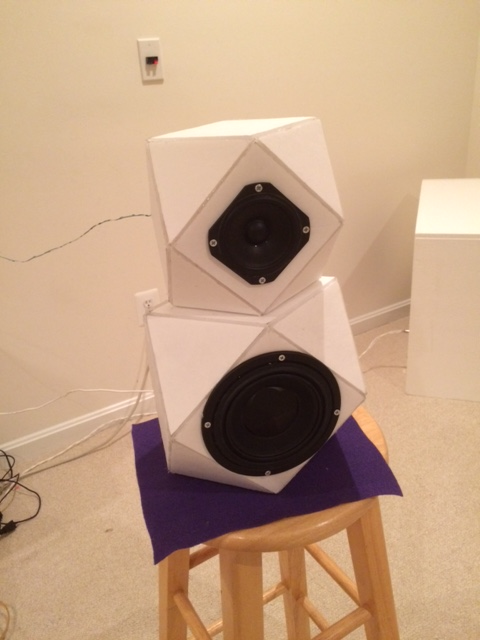
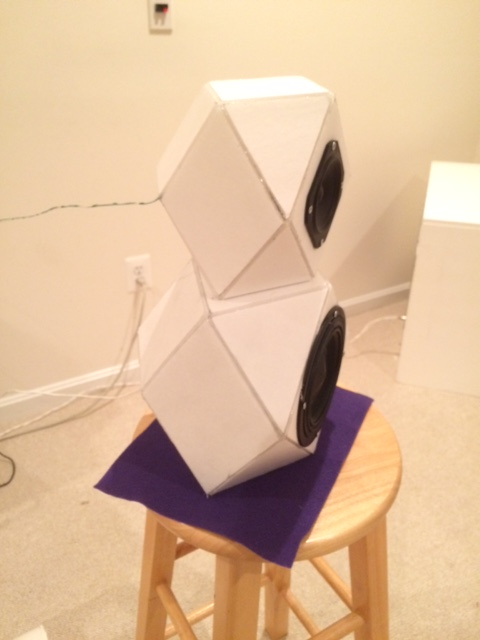
Measures pretty well:
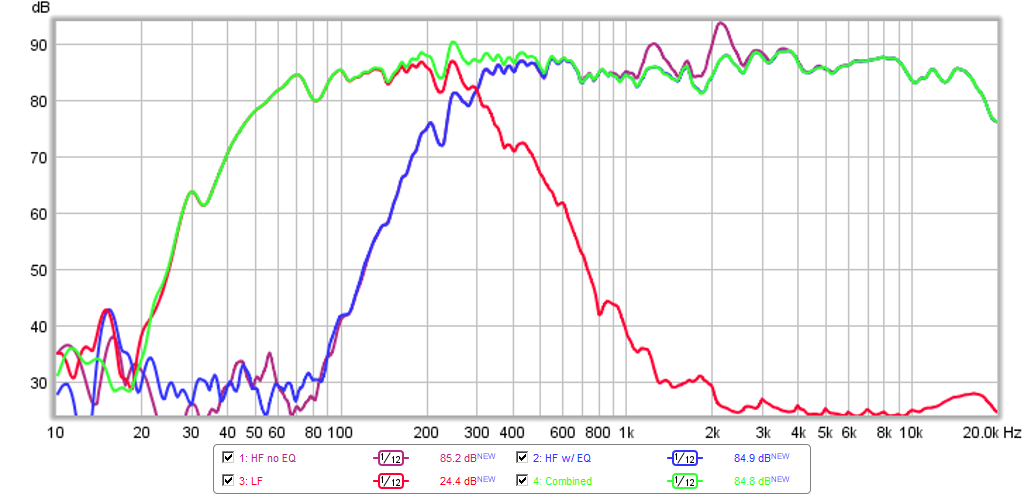
Phase is excellent:
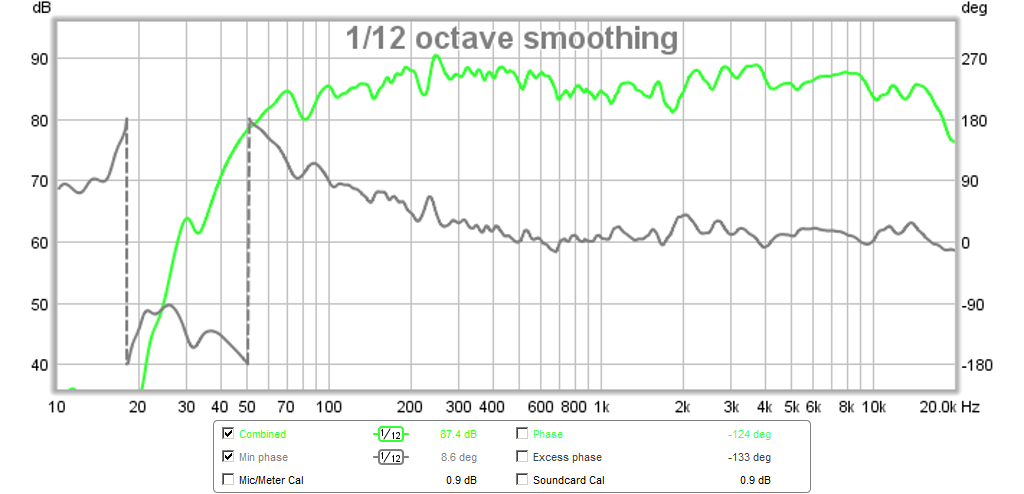
Impulse:
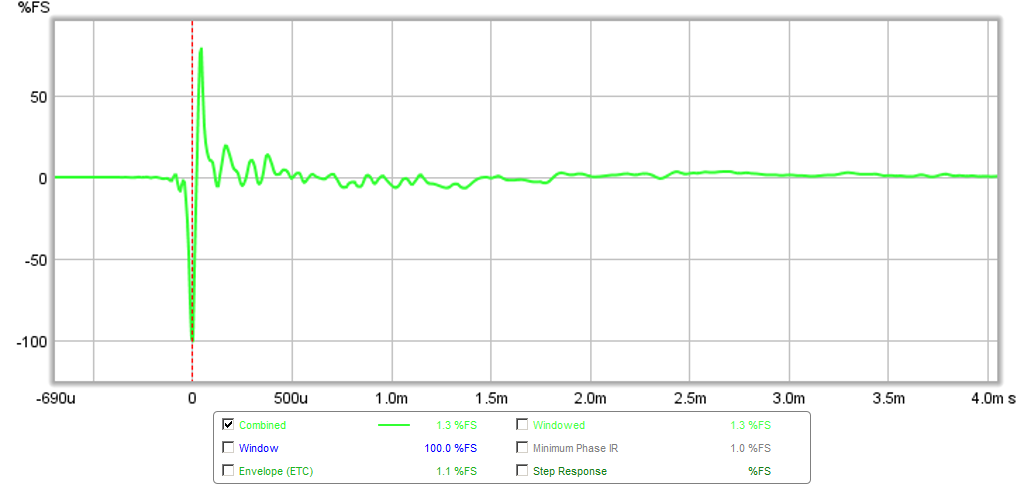
Best part of all is that it took less than 30 minutes to throw together including programming the XO and EQ! 😀
Sounds great!
The two-way Hypercube in a FAST config is done - HyperFAST. 300Hz -24dB BW XO point. Tang Band W5-876SE woofer bottoms, Vifa TC9FD tops, miniDSP and TPA3116D2 amp.
http://www.diyaudio.com/forums/multi-way/265915-hyperfast-hypercube-based-2-way.html#post4143820


Measures pretty well:

Phase is excellent:

Impulse:

Best part of all is that it took less than 30 minutes to throw together including programming the XO and EQ! 😀
Sounds great!
That's pretty neat.
I'm still waiting for someone to do a subwoofer in this shape. If made about 20" tall it'd be appropriate for a 10 or 12" sub driver -- and it would double as an ultra styley side table...
I'm still waiting for someone to do a subwoofer in this shape. If made about 20" tall it'd be appropriate for a 10 or 12" sub driver -- and it would double as an ultra styley side table...
Other than for the 'look' and/or orientation like shown, there's no acoustical advantage over a typical box shape due to the long WLs involved, but it would be nice to see some measurements of this two way layout at various distances from a room corner where it may be the best overall placement choice for this type of cab.
GM
GM
I think a box made like this out of 18mm BB ply for a sub would be very stiff and probably not need internal bracing. I like GregB's suggestion of a stylish end table. Your drinks might get stirred a bit though. 🙂
Some more views from the back:
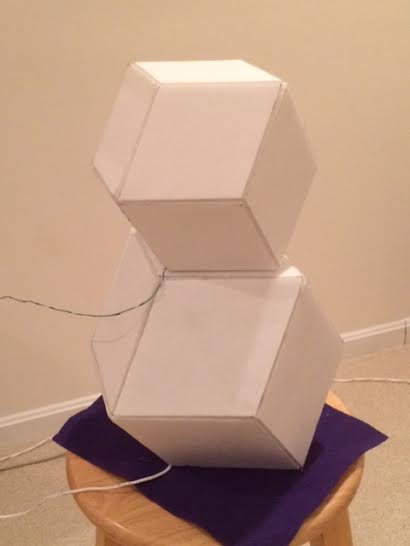
And a real side profile:
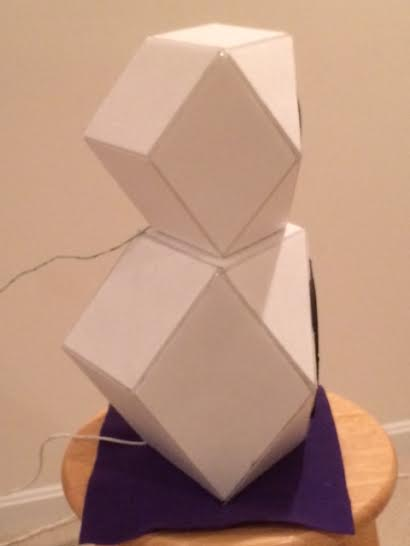
Some more views from the back:

And a real side profile:

- Status
- Not open for further replies.
- Home
- Loudspeakers
- Full Range
- Hypercube Loudspeakers
